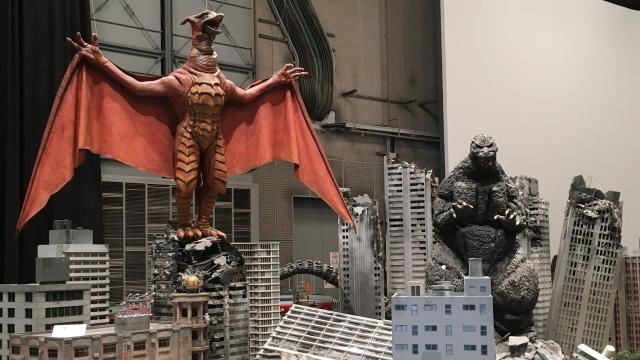Last month in Tokyo, Toho Studios opened its doors to the assembled press, providing a rare look at Godzilla props of yore. We got an up close and personal look at some of the coolest kaiju around—and the cities they’ve destroyed over the years—and we’ve got the pictures to prove it!
Toho’s Toshifumi Shimizu and Kohei Umino, whose actual official job title is “Godzilla Specialist” provided a guided tour and shed light on the future of Toho’s kaiju movies.
“The buildings in front are larger than the ones in the back, which are smaller to create more perspective,” explained Shimizu, who worked as the assistant director during the Millenium Godzilla series.
A whole city sprawled before us. Small buildings. Tiny cars. Cute little trees. The realism is staggering, and I just want to hop on the stage and stomp all over the place. I did not, of course.
A Rodan suit, arms spread, from the 2004 film Godzilla Final Wars loomed overhead, staring down a King Ghidorah suit from 2001’s Godzilla, Mothra and King Ghidorah: Giant Monsters All-Out Attack.
“This is the oldest existing Godzilla suit,” said Shimizu, gesturing to a suit used in both 1994’s Godzilla Vs. Space Godzilla and 1995’s Godzilla Vs. Destroyah. The suit was painted red for the second film, but since the design is a fan favourite, it has since been repainted black.
“This is quite a heavy suit,” explained Shimizu. “Normally, the suit is made entirely from rubber, but in order to light it up in red, the suit’s torso area was also made from plastic.”
“With the rubber and the heavier plastic plus the lights and equipment for the smoke the suit emitted, it weighed 100 kilograms. It was quite heavy.”
According to Shimizu, Godzilla suits typically weigh around 59kg. However, the one from Godzilla Vs. Destroyah weighed 100kg, which puts it up there with the very first 1954 suit for the heaviest Godzilla suit. “The suit actor had a tough time.”
As Umino explained, a suit actor could lose a litre of sweat during a day’s work.
“One suit actor played King Ghidorah, and it was so difficult that the actor could only do short takes,” says Umino, who pointed out the wires holding up the monster’s heads like a puppet. “As you can see, we used wires, but in the movies, you cannot see them. We didn’t erase them with CG, which shows how advanced our film making techniques were.” But some of those techniques are being lost. “I think if we did a King Ghidorah now, people wouldn’t know how to operate the wires.”
The complicated puppetry used for this kaiju suit has apparently not been handed down. But that’s not the only thing that has been lost.
There are Godzilla films dating back to the 1950s, but surely some of the iconic Godzilla suits from before the mid-1990s have survived? Why is the 1994 suit the oldest?
Rubber kaiju, Umino told me later after I pulled him aside for a chat, start to degrade after a few years.
The reason why the 1994 suit is the oldest existing Godzilla suit is that Toho previously did not meticulously preserve or store its archives. Instead, everything was just initially stuffed under a roof and exposed to Japan’s brutally hot summers.
“We didn’t keep archives at all originally,” said Umino. “But after seeing that places like Warner Bros. do, we thought keeping archives was important and that we should, too.”
Now, the Godzilla archives are cataloged and kept in temperature controlled storage in order to preserve them as long as possible. The rubber does still degrade, but the cool temperatures help slow that down. Toho also does maintenance on the suits, such as repainting and patching sections.
While the suits might not hold up well over time, Toho does still have props dating back to the original 1954 film, with the oldest among item being the original Oxygen Destroyer. According to Toho, this is its most important Godzilla prop. The studio does not bring it out on a regular basis and even many Toho employees have not seen it firsthand.
Seeing all the prop images on display made me nostalgic for an era when practical effects ruled, and reminded me of that meme image of George Lucas surrounded by Star Wars models contrasted with him against a green screen.
“International fans often get upset when the Toho Godzilla movies don’t feature a suit actor,” Umino told me. “But for Shin Godzilla, the original plan was to use both a hybrid CG and a suit actor. However, it was ultimately decided that CG worked best for that particular picture.”
Does that mean that all Toho Godzilla movies will be CG?
“I think for future Godzilla movies, whether we use a hybrid of suit acting and CG or just CG will be decided case by case,” he said.
There are signs that Toho is readying its kaiju suit production team. “Last year, we remade the original suit,” Umino explained. This was done to celebrate the character’s 64th anniversary, and the remade suit was shown in Tokyo Midtown.
By Toho having its artisans remake this iconic suit, the studio is ensuring that the artistic tradition that made Godzilla possible lives on.
“There are times that suit acting is best, such as the unexpected ways a building might be destroyed. But with CG,” Umino continued with a smile, “you can easily put those buildings back together.”
Here are even more looks at Toho’s incredible Godzilla props, sets, and suits.
Getting an inside peek at Toho and checking out all these iconic Godzilla suits and props was truly special. Sadly, Toho does not offer tours for the general public, but hopefully, we’ll see more even more suits and sets in future films.
